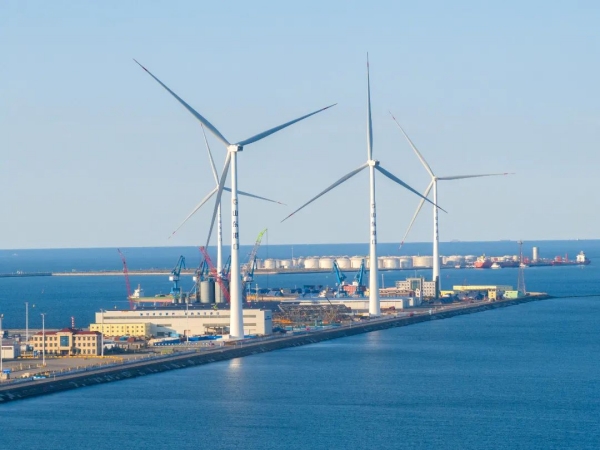Weifang Port has obtained a carbon neutrality certification from the China Classification Society Certification Company to officially become China's first zero-carbon port.

Wind turbines are seen at Weifang Port, Shandong province. [Photo/sasac.gov.cn]
The port, which is managed by Bohaiwan Port Group, itself a subsidiary of Shandong Port Group (SPG), obtained the certificate on October 15. Since its foundation in 2019, SPG has focused on top-level design and prioritized building an internationally competitive smart and green port, aligning with its vision to develop five types of world-class ports.
SPG unveiled the Green and Low-carbon Port Plan during the 14th Five-Year Plan period (2021–2025), in a bid to comprehensively advance green and low-carbon development in the sector. The surge in clean energy utilization at SPG has been noteworthy, rising from 49.5 percent to 62 percent, making green the distinct feature of the port.
Situated on the south coast of Bohai Bay, Weifang Port has a coastline of 5,382 meters. Boasting abundant marine, wind, solar and other resources, the port has become an excellent test site for zero-carbon port construction.
On Sept 30, a total of four 6.7-megawatt wind turbines at Weifang Port were connected to the power grid, with annual generation exceeding 70 million kilowatt-hours. The surplus electricity is made available for use by the wider community, which saved Weifang Port 9.6 million yuan ($1.35 million) in electricity and reduced carbon dioxide emissions by 57,000 metric tons in a single year, with prominent social and environmental gains.
In addition, Weifang Port has advanced a complementary energy system encompassing wind, solar and hydrogen among others. A 3.3-megawatt peak photovoltaic power station has been put into operation, with annual power generation reaching 3.6 million kWh. The designed daily hydrogen refueling capacity of hydrogen refueling stations at Weifang Port can satisfy the needs of four hydrogen-powered heavy-duty trucks.
A multi-energy supply system has been established at Weifang Port, forming a zero-carbon energy structure integrating wind, solar, and energy storage, officially achieving Zero-Carbon Port 2.0 (narrowly defined as a zero-carbon port). Weifang Port strives to become the industry's first Zero-Carbon Port 3.0 (broadly defined as a zero-carbon port) characterized by "green and low-carbon development throughout the entire logistics chain".
(Executive editor: Zhu Zeya)